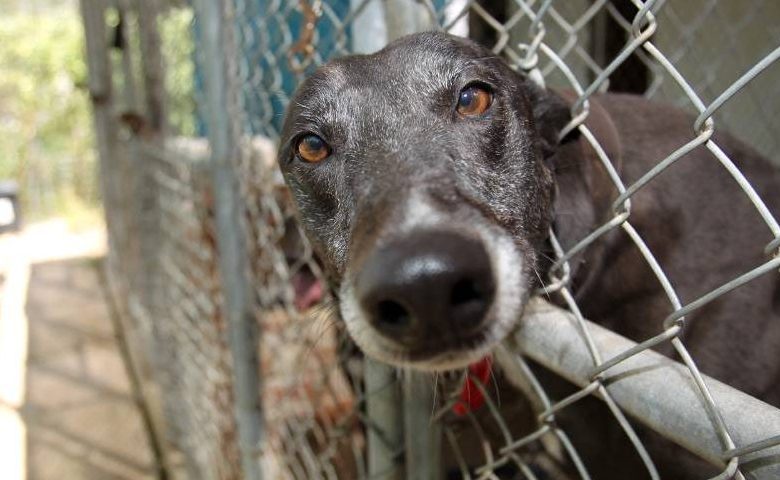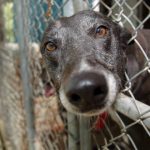What To Feed Your Adopted Greyhound – And What NOT To Feed Your Adopted Greyhound
At Gumtree Greys, we are all too aware that our beautiful rescued greyhounds generally have had a dreadful start to their lives. All we want for them is to be adopted into loving homes where they can receive all the security, love and care they deserve and could want for the rest of their lives.
The most common question we get is, ‘what’s the best food to feed my greyhound?’
Greyhounds, like all dogs, benefit most from a healthy and well balanced diet. You should always feed your dog the best quality food you can afford. Cheap dog food brands do not provide the nutrition your greyhound needs and in fact, can cause some detriment to your dog. If in doubt about what you should buy, your vet can recommend good quality kibble and/or wet food. Unless it is a good quality brand specifically recommended by your vet, we would suggest that you do not feed your dog’s tinned food. A lot of tinned food contains fillers that aren’t good for your dog and can cause lots of intestinal difficulties. If your dog suffers from diarrhoea after eating tinned food, it’s time to change food immediately. Like people, dogs should eat food that is as pure and unprocessed as possible.
If your greyhound is healthy and happy, this will be very obvious through their coat, skin and eyes. A bright shiny coat, smooth and healthy skin and bright, clear eyes are all indicators that your dog is in excellent health.
Even though they sleep for long stretches, younger greyhounds still have large bursts of energy and like to play. To maintain an active and healthy lifestyle, your greyhound requires high-quality food that delivers all the nutrients the dog needs over the course of the day.
Human food and dog food sometimes do not mix well at all, and giving your dog some human food can have tragically fatal consequences. However, that’s not to say that you can’t give the fur babies a special treat of human food. If you remember always to ensure that the ‘treat food’ is limited to small portions given infrequently and that the food is pure, cooked and not heavily seasoned, salted or too fatty, you should be ok.
Some basic rules to follow:
- Greyhounds should eat between 250-300 grams of meat per day, depending upon the size of the dog. This meat should be supplemented with vegetables (see list of good and bad vegetables), fish oil and some good quality dry food.
- Lean cuts of meat that have been cooked thoroughly should be fine. Remove all visible fat, including the skin, from chicken. Remove all bones from cooked meat.
- Fruit – some fruit is great for dogs, and they love it as a treat. Apples, oranges, bananas and watermelon make very special healthy treats. Just remember to remove all seeds first. Leaves, stems, and seeds in fruit can cause serious problems.
- Vegetables – some vegetables are very good for your dog and make great treats. Carrot sticks, green beans, slices of zucchini or cucumber are all good. Cooked potato is ok too. Please see “foods to avoid” below in relation to raw potato, which is a no-no.
- Rice and Pasta – these are great for your dog as long as they’re cooked properly. If your dog has been ill recently or had some tummy upset, plain white rice with a small amount of boiled chicken (without skin) can make your dog feel much better.
Remember that greyhounds are notorious bench surfers. Below is a list of foods and substances that can be harmful, and even fatal, to dogs. Please ensure that you keep all food, even good food, out of your dog’s reach. Even though you may not feed harmful food to your dog deliberately, they may eat it accidentally.
Foods to Avoid:
Avocado: Avocado contains a substance called persin, which in certain amounts is toxic for dogs. Persin is found in all parts of avocadoes – leaves, seed and the bark from the trees as well as in the avocado fruit itself.
Alcohol: One would think that this really didn’t need to be said, but alas, some people are idiots. Alcohol has the same effect on a dog’s liver and brain that it does on humans, but it takes far, far less to do the same amount of damage. Even a small amount of alcohol can be fatal for a dog – symptoms include vomiting, diarrhoea, central nervous system depression, coordination difficulties, erratic breathing, and falling into a coma.
Chocolate: Most people already know that chocolate is very, very bad for dogs. The killer ingredient in chocolate is theobromine and is found in all chocolate, including white. The most dangerous chocolate for dogs is dark chocolate, unsweetened baking chocolate and chocolate mulch. Even small amounts of chocolate can do dreadful damage. Symptoms to watch are vomiting, diarrhoea, excessive thirst, abnormal heartbeat or palpitations, muscle tremors and seizures. By the time your dog starts having seizures, it’s probably too late.
Coffee, Tea and Other Caffeine Products: Caffeine in large enough quantities will kill your dog. If your dog has ingested a fatal dose of caffeine, nothing will save it. Symptoms of caffeine poisoning include restlessness, rapid breathing, heart palpitations, muscle tremors, fits and bleeding. In addition to coffee and tea, caffeine is also found in cocoa, chocolate, colas (never give your dog Coke or cola under any circumstances), some cold medicines and pain killers, and also in stimulant drinks such as Red Bull and V. Red Bull may give people wings, but it will give your dog angel wings.
Fat Trimmings and Bones: Feeding your dog table scraps isn’t a good idea at the best of times, but some table scraps will be downright dangerous. Cooked bones and meat fat are a big no-no. Both of these are bad news for your dog’s wellbeing. Fat, both cooked and uncooked, can cause pancreatitis. You should never give your dog cooked bones. Cooked bones can splinter and the consequences could be an obstruction to the airway or digestive system and/or lacerations to the internal system. Either way, this is not good, and your dog may suffer a fatal episode.
Grapes and Raisins: All very well for Antony and Cleopatra, but not so good for greyhounds. Grapes and raisins can cause kidney failure in dogs, and it doesn’t take much to trigger poisoning. The skins of these fruits contain lots of enzymes that are harmful to dogs, and the pulp of the fruit is also harmful. Repeated vomiting in your dog is an early and very clear sign. Within a rather short period of time, the dog will become lethargic and depressed and, shortly afterwards, is likely to collapse.
The Kitchen Pantry: The kitchen pantry contains many enticing smells for our furry four legged friends. Unfortunately, some of the enticing smells also mean poison. The kitchen pantry is definitely a No-Go Zone. Please keep your pantry secure so that the dog cannot get in there. All foods should be kept above the dog’s reach. Please be aware that common cooking ingredients such as baking powder and baking soda are highly toxic for dogs, as are nutmeg and some other spices. If, like my naughty girl Tilly, your dog is adept at breaking into the pantry in search of forbidden treats, please, please, please ensure that the doors are secured.
Lollies, Sweets and Chewing Gum: Let’s face it, people, who don’t love a sneaky bag of snakes at around 3:30 pm to kick that afternoon drowsiness? I’ll tell you who – your dog! The evil lurking in your sweets is a substance called xylitol. It’s a sweetener and it’s found in many products, including lollies, chewing gum, toothpaste, some diet foods and also in baked goods. In your dog, xylitol will cause a rapid spike in the insulin levels in the blood. This will cause the dog’s blood sugar level to drop rapidly and can also cause liver failure. Again, the symptoms to watch out for are vomiting, general lethargy and significant loss of coordination. Seizures are also not uncommon. Depending upon the amount consumed, the dog can die from liver failure in just a couple of days.
Macadamia Nuts: Let’s be very clear about this – macadamia nuts are fatal for dogs. You shouldn’t feed your dog macadamia nuts or any foods containing macadamia. The symptoms of macadamia nut poisoning are similar to other poisoning indicators – vomiting, rapid heart rate, muscle tremors, paralysis of the hindquarters, general leg weakness and inability to stand, elevated body temperature etc. If your dog is unlucky enough to eat chocolate with macadamias in it, the symptoms will become a lot worse a lot more quickly.
Medication (Human): Believe it or not, a severe toxic reaction to drugs/medicines routinely prescribed for humans is the most common cause of poisoning in all dogs. On all medication bottles or packets, there is a clear warning “Keep Out Of Reach Of Children”. This includes Fur Children. Never, ever, ever give your dog any ‘over the counter’ medications unless specifically instructed to do so by your dog’s vet. Ingredients such as ibuprofen or acetaminophen are standard ingredients in pain relievers and cold/cough medicine. Good for humans. Fatal for dogs.
Milk and other Dairy Products: Look here, I’m as guilty as the next person of giving my gorgeous greys an ice cream on a hot day. Some dogs do not show any reaction to milk or dairy products. Be aware that milk and dairy products can cause an allergic reaction in your dog. The enzymes and lactose in dairy cause all sorts of allergies in people and can do the same in dogs. The most common indication that your beloved hound doesn’t react well to dairy is the onset of diarrhoea and other digestive upsets, as well as sudden itchiness. If your dog starts becoming itchy for no apparent reason and you’ve been feeding it dairy products, it’s probably time to stop. The sooner, the better.
Onions and Garlic: Look, people, the jury is out on the garlic. I know of many people who give their dogs garlic in very small doses (usually in the minced form, ie, ‘jarlic’) to ward off fleas. When I say very small doses, I mean barely a teaspoon in at least 2kg or more of meat. It’s up to you, but don’t say you weren’t warned! If you don’t know, then it’s best to avoid taking the chance. All forms of onion should be avoided completely, whether it be raw, cooked, dehydrated or in powdered form. The enzymes in onion destroy the red blood cells, leading to anaemia and poisoning. Be aware that some baby food has powered onion in it, so this should be avoided as well. Symptoms of toxicity from ingesting onion include weakness, vomiting, loss of interest in food, lethargy and difficulty breathing.
The Three Deadly Ps – Persimmons, Peaches and Plums: These fruits all have one nasty thing in common – seeds/pits. Persimmon seeds are quite small and can cause a blockage and/or inflammation of the small intestine. Intestinal obstruction can also occur from pits contained in peaches and plums. To make matters worse, peach and plum pits contain cyanide, which is fatal to just about every living thing. Most people wouldn’t make a habit of eating cyanide deliberately and, consequently, don’t eat peach or plum pits. However, dogs don’t know the difference and may eat these by accident.
Potatoes (Raw): Do not feed raw potatoes to your dog, and do not allow your dog to eat any potato plants if you grow potatoes in your garden. The enzymes in raw potatoes are very harmful and will induce symptoms of food poisoning. Unlike in cooked potatoes, some of the starch in raw potatoes is digested poorly. It’s called ‘resistant starch’ and passes through the small intestine into the large intestine, where it ends up being fermented by the flora that live in the large intestine. As a consequence, your dog may experience increased faecal bulk, bloating and very unpleasant gastrointestinal effects. The potato plant itself produces some defensive (ie, toxic) substances in the upper plant (being the stems, leaves and above-ground potatoes themselves). Sometimes, toxic alkaloids, such as solanine, might also be present. Cooked potato is much more healthy, both for humans and for dogs!
Raw Eggs: The jury’s out on this one too, but it’s good to get some facts. I’ve been feeding raw eggs to my greyhounds for years without any apparent symptoms, but now I’m not so sure. I always thought that giving my greys raw eggs was beneficial for their coats. However, some vets will tell you that there are two issues arising out of feeding raw eggs to your dog. The first is that they may experience food poisoning from unpleasant bacteria such as Salmonella or E. coli. The second issue is that there are enzymes in raw eggs that prohibit the absorption of a particular B vitamin. This may result in skin problems and coat problems if raw eggs are fed over a long period of time. If in doubt, skip the raw eggs and give your dog cooked eggs instead. Or skip the eggs altogether.
Raw Meat and Fish: Again, raw meat can contain bacteria that cause food poisoning. Be careful with the meat you feed your dogs, and make sure that it’s been handled and stored properly. Although fish provides your dog with excellent Omega 3 and oils for their skin and coat, fish can have its own problems. Humans know this all too well. Certain kinds of fish, such as salmon and trout, can contain a parasite that will be fatal if left untreated reasonably quickly after ingestion. You may have heard of ‘fish disease’ or ‘salmon poisoning disease’. This is caused by the parasite. Poisoning from this parasite can be fatal within two weeks. Clear signs of parasite poisoning are vomiting, high fever and swollen lymph nodes. All fish given to dogs should be cooked thoroughly.
Salt: As it is with humans, too much salt can be detrimental to your dog’s health. Salty snacks such as chips and pretzels, although delicious, can be harmful. Too much salt will cause excessive thirst in your dog, leading to increased urination and also to sodium ion poisoning. As with many other types of poisoning, symptoms of sodium ion poisoning are vomiting, diarrhoea, lethargy and depression, muscle tremors, high fever and seizures. Dogs can die from a toxic level of salt.
Sugar: Unless you have been living under a rock, you should be aware that too much sugar in your diet is very bad for you. Sugar causes obesity, tooth decay and other dental problems and can lead to Diabetes. Guess what? The very same principle applies to your dog. Sugar is not a naturally occurring substance in a dog’s diet and should not be given to them.
Yeast: More people seem to enjoy baking their own bread at home. We all know that when baking bread, the dough must rise before it’s cooked. There’s nothing more pleasing to a baker’s eye than to see dough rising. Well…..the bad news is that your dog’s stomach will do exactly the same thing if the dog eats raw dough. As the yeast activates and causes the dough to rise, the dog’s stomach will swell, stretching the abdomen and causing intense pain. Additionally, as the yeast ferments (which is what causes the dough to rise), it produces alcohol as a by-product. This can lead to poisoning (see alcohol above on this list).
SIMPLE BUT CRITICAL ADVICE:
Always keep the number of your dog’s vet close to the phone or store in speed dial on your mobile.
Dogs explore their worlds with their noses and mouths – smell and taste are vital to them. No matter how cautious we are and how many precautions we take, accidents may happen, and our beloved hounds may ingest something that they shouldn’t have.
If you suspect at all that your dog has eaten something dangerous, call your vet or the local emergency vet immediately. It’s better to be safe and feel a bit foolish than to ignore the symptoms and grieve the loss of your beloved hound because you didn’t act quickly enough.
Last modified: November 19, 2023



